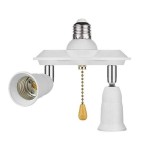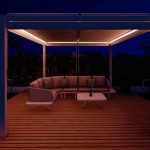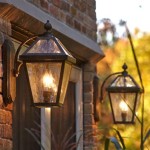The Comprehensive Guide to Quality Outdoor Solar Lighting
Outdoor solar lighting has evolved significantly, transitioning from novelty items to reliable and efficient solutions for illuminating outdoor spaces. This article delves into the various aspects of quality outdoor solar lighting, covering its functionality, technology, types, and factors crucial for selecting the appropriate lighting for specific needs.
Understanding the Functionality and Technology Behind Solar Lighting
Solar lights operate on a simple yet effective principle. They harness solar energy during daylight hours through photovoltaic (PV) cells, converting sunlight into electricity. This electricity is then stored in rechargeable batteries. At dusk, a light sensor activates the light, drawing power from the battery to illuminate the area. The efficiency and longevity of a solar light depend heavily on the quality of its individual components: the solar panel, battery, and LED light source.
The solar panel's efficiency is measured by its ability to convert sunlight into electricity. Higher efficiency panels capture more energy in a given area, leading to faster charging times and longer illumination periods. Monocrystalline solar panels are generally considered the most efficient, followed by polycrystalline panels. Amorphous silicon panels, while less efficient, are more cost-effective and perform better in low-light conditions.
The battery serves as the energy reservoir, storing the electricity generated by the solar panel. Lithium-ion (Li-ion) batteries are commonly used due to their high energy density, long lifespan, and ability to undergo numerous charge-discharge cycles. Nickel-metal hydride (NiMH) batteries are a less expensive alternative, but they typically have a shorter lifespan and lower energy density. The battery's capacity, measured in amp-hours (Ah), determines how long the light can operate before needing to recharge.
The light source is typically a light-emitting diode (LED). LEDs are energy-efficient, long-lasting, and produce minimal heat. They are available in a wide range of colors and brightness levels, allowing for customization of the lighting effect. The brightness of an LED is measured in lumens, with higher lumen values indicating a brighter light. The color temperature, measured in Kelvin (K), determines the light's color appearance. Lower Kelvin values (e.g., 2700K) produce a warm, yellowish light, while higher Kelvin values (e.g., 6000K) produce a cool, bluish-white light.
Exploring the Different Types of Outdoor Solar Lights
The market offers a diverse range of outdoor solar lights, each designed for specific applications and aesthetic preferences. Understanding the characteristics of each type is essential for making an informed purchasing decision.
Solar pathway lights are designed to illuminate walkways, driveways, and garden paths. They are typically low-profile and emit a soft, diffused light to guide pedestrians safely. Quality pathway lights should be durable and weather-resistant to withstand outdoor elements. They often feature automatic on/off functionality, activating at dusk and deactivating at dawn.
Solar spotlights are designed to highlight specific features, such as trees, shrubs, or architectural elements. They emit a focused beam of light to create dramatic effects and add visual interest to the landscape. Adjustable spotlights allow for precise aiming, enabling users to customize the lighting effect. Look for spotlights with high lumen output for optimal illumination.
Solar floodlights are designed to illuminate large areas, such as patios, decks, or security perimeters. They emit a wide beam of light to provide ample illumination for safety and security. Floodlights typically have higher lumen output than pathway lights or spotlights. Motion-activated floodlights can provide added security by turning on automatically when movement is detected.
Solar string lights are decorative lights that add ambiance and charm to outdoor spaces. They are available in a variety of styles, including fairy lights, globe lights, and novelty shapes. String lights are ideal for decorating patios, pergolas, and fences. Look for string lights with durable, weather-resistant construction.
Solar wall lights are mounted on walls to provide ambient or task lighting. They can be used to illuminate doorways, porches, or outdoor living areas. Some wall lights feature motion sensors for added security. Consider the style and color of the wall light to complement the building's architecture.
Solar garden lights are designed to add decorative lighting to gardens and flowerbeds. They are available in a variety of shapes and sizes, often resembling flowers, animals, or other decorative objects. Garden lights are typically low-intensity and emit a soft, diffused light. They add visual interest and enhance the beauty of the garden at night.
Factors Determining the Quality and Performance of Solar Lights
Selecting quality outdoor solar lighting involves considering several factors that contribute to its overall performance, durability, and lifespan. Prioritizing these factors ensures a worthwhile investment that provides reliable illumination for years to come.
The quality of the solar panel is paramount. Higher efficiency panels, as previously mentioned, capture more sunlight and charge the battery more quickly. Look for panels made from durable materials that can withstand exposure to the elements. The panel should be properly sealed to prevent water damage and corrosion. Check the manufacturer's specifications for the solar panel's power output and efficiency rating.
Battery quality and capacity directly impact the light's runtime. Lithium-ion batteries are generally preferred for their longevity and high energy density. Consider the battery's capacity in amp-hours (Ah) to determine how long the light can operate on a full charge. A larger capacity battery will provide longer runtime, but it may also require a longer charging time. Also, ensure the battery is protected from extreme temperatures, as excessive heat or cold can degrade its performance and lifespan.
The LED light source is another critical factor. LEDs should be energy-efficient and long-lasting. Look for LEDs with a high lumen output for optimal brightness. The color temperature of the LED should be appropriate for the intended application. Warm white light (2700K-3000K) is generally preferred for ambient lighting, while cool white light (4000K-6000K) is better suited for task lighting. Check the manufacturer's specifications for the LED's lifespan and light output.
Construction materials and weather resistance are essential for durability. Solar lights should be made from durable, weather-resistant materials that can withstand exposure to sun, rain, snow, and wind. Look for lights with an IP (Ingress Protection) rating that indicates their level of protection against dust and water. A higher IP rating indicates better protection. Common materials include stainless steel, aluminum, and durable plastics. Avoid lights made from cheap, flimsy materials that are likely to break or corrode.
Installation and placement significantly affect performance. Solar lights should be placed in locations that receive ample sunlight throughout the day. Avoid placing them in shaded areas, as this will reduce their charging efficiency and runtime. Ensure that the solar panel is positioned to face the sun for optimal energy capture. Follow the manufacturer's instructions for proper installation, including any necessary wiring or mounting hardware. The placement should also consider aesthetics and safety, ensuring the lights enhance the landscape and provide adequate illumination for pathways and other areas.
Understanding the warranty and customer support offered by the manufacturer is crucial. A reputable manufacturer will offer a warranty on their solar lights, covering defects in materials and workmanship. Read the warranty terms carefully to understand what is covered and for how long. Check online reviews and forums to gauge the manufacturer's reputation for customer support. A responsive and helpful customer support team can be invaluable if you encounter any problems with your solar lights.
Cost versus value is a common consideration. While lower-priced solar lights may seem attractive, they often compromise on quality and performance. Investing in higher-quality solar lights may cost more upfront, but they will typically provide better performance, longer lifespan, and lower long-term costs due to reduced replacement frequency. Consider the total cost of ownership, including the initial purchase price, replacement costs, and potential energy savings.
Motion sensor capabilities incorporated into solar lights enhance security and energy efficiency. These lights activate only when motion is detected, conserving battery power and extending runtime. Sensitivity and range adjustments allow customization to specific needs, minimizing false triggers. Motion-activated lights are particularly useful for illuminating doorways, driveways, and other areas where security is a concern.
Dimming and color changing features provide flexibility and customization. Some solar lights offer dimming capabilities, allowing users to adjust the brightness level to suit their preferences. Color changing lights can create a festive or decorative atmosphere. These features add versatility and enhance the overall user experience.

Premium Quality 360 Degree Solar Led Garden Street Lights

Best Solar Lights On Test In 2024 Bbc Gardeners World

Is Solar Lighting Any Good Indoor Outdoor Guides Resources Centre

Brilliant Quality Solar Light For Outdoor Lighting Manufacturers And S China Factory Nomo Group

Ghodec Outdoor Solar Lights Firework Light 4 Pack Garden With 120 Led Stake Starburst 8 Modes Patio Fairy For Lawn Decor Com

Premium Quality 360 Degree Solar Led Garden Street Lights

The 3 Best Smart Outdoor Lights For Backyards Of 2024 Reviews By Wirecutter

Solar Garden Light Outdoor Decoration Decorative Waterproof Firework Copper Wire Backyard Vitality Channel Com

Solar Lights Outdoor Waterproof Multi Sets

2200w Led Outdoor Solar Light Remote Control Wall
Related Posts







